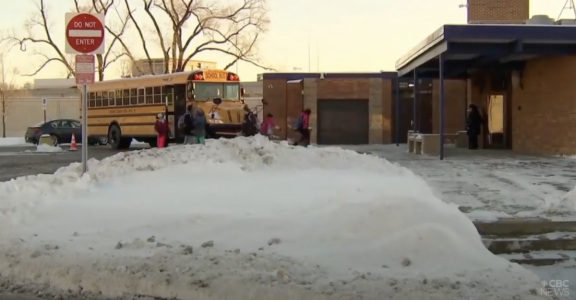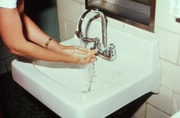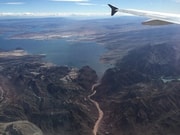Dangerous freeze alert! Protect yourself from the deadly cold wave sweeping the US
- Replies 0
As the United States reels from a weekend of devastating floods that claimed at least 14 lives, a new threat looms large over the nation's midsection.
A bone-chilling cold, has taken hold of the Rockies and Northern Plains, prompting the National Weather Service to issue warnings of “life-threatening cold.”
With wind chills plummeting to minus 60 Fahrenheit in parts of North Dakota and minus 50 F in Montana, residents are facing conditions that are not just uncomfortable, but potentially fatal.
The GrayVine community, particularly those of us who have weathered many a storm, knows the importance of staying informed and prepared. This latest cold snap is no exception.
A polar vortex, the sign of extreme cold, caused warnings which spanned an 11-state swath from the Canadian border down to Oklahoma and central Texas.
By midweek, near-record cold temperatures and wind chills in the single digits are expected to grip the region.
Meteorologists had predicted this to be the 10th and coldest polar vortex event of the season, with Arctic forces pushing frigid air that typically remains near the North Pole down into the US and Europe.

The recent floods in Kentucky and Appalachia, which left at least 13 dead, are a testament to the destructive power of severe weather. 12 deaths were attributed to the flooding in Kentucky while one fatality was confirmed in West Virginia, with several people still missing.
Two deadly vehicle crashes were linked to the severe weather and at least 1,000 people had to be rescued from the floods. In West Virginia, the governor has requested a disaster declaration for the affected regions, and in Atlanta, a person was tragically killed by a falling tree.
Source: FOX Weather / Youtube.
Some parts of Kentucky and Tennessee experienced 6 inches of rain, leading to submerged cars and buildings as well as mudslides blocking roads.
As the cold front moves eastward, it brings with it snowstorms that have already claimed lives, including a Nebraska state trooper. Michigan, Colorado, and parts of the Northeast are also grappling with treacherous travel conditions due to ice and snow.
In Detroit, a burst water main dating back to 1930 has flooded neighborhoods, illustrating the challenges of aging infrastructure in extreme weather. The city is working to manage the crisis, offering shelter and assistance to those affected.
Governor Patrick Morrisey has asked President Donald Trump to issue a disaster declaration for a 13-county region affected by flooding.
In Logan, West Virginia, authorities acted on the spill of acidic water from a coal mine–this caused a damaged road which made it impassable. Meanwhile, in Atlanta, a person died from injuries following a large tree falling on their home.
This dangerous freeze is a stark reminder of the power of nature and the importance of being prepared. Here are some vital tips to protect yourself and your loved ones from the deadly cold:
1. Limit exposure: Stay indoors as much as possible. If you must go outside, dress in layers and cover all exposed skin to prevent frostbite, which can occur within minutes in such extreme temperatures.
2. Check on neighbors: Particularly the elderly and those with limited mobility, to ensure they have adequate heating and supplies.
3. Protect your pets: Bring animals indoors. They are also at risk of frostbite and hypothermia.
4. Maintain your vehicle: Keep your car's gas tank at least half full to avoid fuel line freeze-up, and stock an emergency kit with blankets, food, water, and a first-aid kit.
Source: TODAY / Youtube.
5. Prevent pipe freezing: Keep your home's temperature at 65 degrees or higher, even overnight, and allow faucets to drip slightly to prevent pipes from freezing.
6. Be prepared for power outages: Have flashlights, batteries, and a battery-powered radio on hand. Avoid using candles for risk of fire.
7. Recognize hypothermia: Symptoms include shivering, exhaustion, confusion, fumbling hands, memory loss, slurred speech, and drowsiness. If you suspect someone has hypothermia, seek medical attention immediately.
Also read: Are you mistaking frostbite for hypothermia? Learn the deadly difference!

Have you ever experienced extreme cold like this before? How did you prepare and stay safe? Share your thoughts and stories in the comments below, and please stay safe.
A bone-chilling cold, has taken hold of the Rockies and Northern Plains, prompting the National Weather Service to issue warnings of “life-threatening cold.”
With wind chills plummeting to minus 60 Fahrenheit in parts of North Dakota and minus 50 F in Montana, residents are facing conditions that are not just uncomfortable, but potentially fatal.
The GrayVine community, particularly those of us who have weathered many a storm, knows the importance of staying informed and prepared. This latest cold snap is no exception.
A polar vortex, the sign of extreme cold, caused warnings which spanned an 11-state swath from the Canadian border down to Oklahoma and central Texas.
By midweek, near-record cold temperatures and wind chills in the single digits are expected to grip the region.
Meteorologists had predicted this to be the 10th and coldest polar vortex event of the season, with Arctic forces pushing frigid air that typically remains near the North Pole down into the US and Europe.

A polar vortex has brought “life-threatening cold” to the midsection of the United States, with wind chills dropping to extreme levels in states like North Dakota and Montana. Image source: CBC News / Youtube.
The recent floods in Kentucky and Appalachia, which left at least 13 dead, are a testament to the destructive power of severe weather. 12 deaths were attributed to the flooding in Kentucky while one fatality was confirmed in West Virginia, with several people still missing.
Two deadly vehicle crashes were linked to the severe weather and at least 1,000 people had to be rescued from the floods. In West Virginia, the governor has requested a disaster declaration for the affected regions, and in Atlanta, a person was tragically killed by a falling tree.
Source: FOX Weather / Youtube.
Some parts of Kentucky and Tennessee experienced 6 inches of rain, leading to submerged cars and buildings as well as mudslides blocking roads.
As the cold front moves eastward, it brings with it snowstorms that have already claimed lives, including a Nebraska state trooper. Michigan, Colorado, and parts of the Northeast are also grappling with treacherous travel conditions due to ice and snow.
In Detroit, a burst water main dating back to 1930 has flooded neighborhoods, illustrating the challenges of aging infrastructure in extreme weather. The city is working to manage the crisis, offering shelter and assistance to those affected.
Governor Patrick Morrisey has asked President Donald Trump to issue a disaster declaration for a 13-county region affected by flooding.
In Logan, West Virginia, authorities acted on the spill of acidic water from a coal mine–this caused a damaged road which made it impassable. Meanwhile, in Atlanta, a person died from injuries following a large tree falling on their home.
This dangerous freeze is a stark reminder of the power of nature and the importance of being prepared. Here are some vital tips to protect yourself and your loved ones from the deadly cold:
1. Limit exposure: Stay indoors as much as possible. If you must go outside, dress in layers and cover all exposed skin to prevent frostbite, which can occur within minutes in such extreme temperatures.
2. Check on neighbors: Particularly the elderly and those with limited mobility, to ensure they have adequate heating and supplies.
3. Protect your pets: Bring animals indoors. They are also at risk of frostbite and hypothermia.
4. Maintain your vehicle: Keep your car's gas tank at least half full to avoid fuel line freeze-up, and stock an emergency kit with blankets, food, water, and a first-aid kit.
Source: TODAY / Youtube.
5. Prevent pipe freezing: Keep your home's temperature at 65 degrees or higher, even overnight, and allow faucets to drip slightly to prevent pipes from freezing.
6. Be prepared for power outages: Have flashlights, batteries, and a battery-powered radio on hand. Avoid using candles for risk of fire.
7. Recognize hypothermia: Symptoms include shivering, exhaustion, confusion, fumbling hands, memory loss, slurred speech, and drowsiness. If you suspect someone has hypothermia, seek medical attention immediately.
Also read: Are you mistaking frostbite for hypothermia? Learn the deadly difference!
Key Takeaways
- A polar vortex has brought “life-threatening cold” to the midsection of the United States, with wind chills dropping to extreme levels in states like North Dakota and Montana.
- Severe weekend flooding in the Eastern U.S., particularly in Kentucky and Tennessee, caused at least 14 deaths, with numerous people rescued from the dangerous conditions.
- An Arctic front is set to push near-record cold temperatures across an 11-state swath of the U.S., affecting areas from the Canadian border down to Oklahoma and central Texas.
- The extreme cold has disrupted daily life and transportation, with avalanche warnings in the Rockies, a state trooper killed in Nebraska, and a neighborhood in Detroit submerged due to a burst water main.
Have you ever experienced extreme cold like this before? How did you prepare and stay safe? Share your thoughts and stories in the comments below, and please stay safe.






